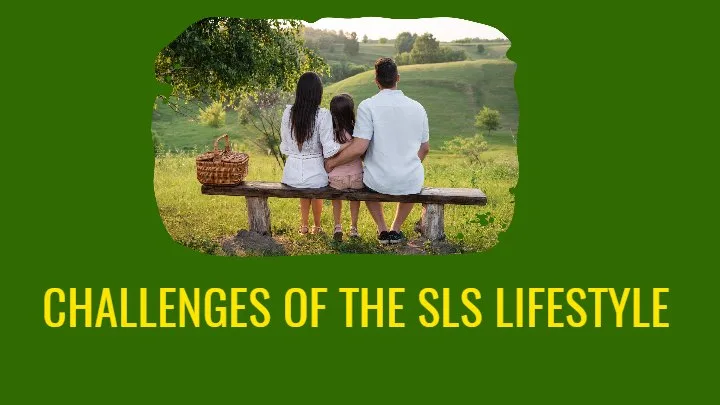The post SLS Lifestyle: A Path to Success, Fulfillment, and Connection first appeared on Article Thirteen.
]]>As I have explored this lifestyle over the past few years, I have found it to be a rewarding and transformative journey. Here, I will share my experiences with the SLS Lifestyle, including the benefits I have gained, the challenges I have faced, and my vision for the future of this community. With insights from my exploration of this lifestyle, I hope to provide a helpful guide for others considering Write For Us Lifestyle.
The Origins and Values of the SLS Lifestyle

Before diving into the specifics of the SLS Lifestyle, it is helpful to understand where this philosophy originated from and the core values that inform it.
History
While the SLS Lifestyle is relatively new, its roots draw from several older philosophical and social movements. Key among these are the human potential movement and the rise of the holistic health movement.
The human potential movement gained popularity in the 1960s and focused on developing human capacities and reaching our highest individual potential. This movement encouraged self-actualization, creativity, and well-rounded personal growth.
Finally, the holistic health movement emphasized nurturing the mind, body, and spirit in an integrated way. This movement looked beyond Western medicine to incorporate Eastern and alternative healing practices.
The SLS Lifestyle integrates the emphases on self-development and holistic wellness from these earlier movements. While “SLS Lifestyle” only came into use in the early 2000s, the philosophy builds on the groundwork of these prior social shifts.
Values
Several vital values inform the SLS Lifestyle:
- Authenticity: Living in alignment with one’s true self and desires and rejecting societal conditioning that prevents self-expression.
- Growth: Actively seeking out new experiences, knowledge, and relationships to facilitate continuous betterment and evolution.
- Freedom: Structuring one’s lifestyle to maximize autonomy, choice, and independence and breaking free from restrictive norms and expectations.
- Connection: Forging profound bonds with others through vulnerability, intimacy, and transparent communication and prioritizing close relationships.
- Balance: Striking a mindful equilibrium between different aspects of life and moderating and integrating priorities related to self, work, relationships, health, spirituality, etc.
This value system provides the ideological foundation for the SLS Lifestyle. These values drive the goals and behaviors adopted by those living this lifestyle, as we will explore in the next section.
The 3 Pillars: Success, Lifestyle, and Satisfaction

The SLS Lifestyle, as the name suggests, is built on three foundational pillars—Success, Lifestyle, and Satisfaction. These three pursuits make up the core focus areas of this lifestyle philosophy.
Success
The SLS Lifestyle encourages defining Success based on personal values, not societal metrics. Rather than chasing money, status, or fame, the goal is to achieve things you find subjectively meaningful. This could involve anything from starting a nonprofit to completing a marathon.
Here are some fundamental principles for crafting your version of Success:
- Introspect on your core values and sense of purpose. What legacy do you want to leave behind? What fulfills you?
- Set boundary-pushing goals aligned with your values.
- Replace comparison with self-competition. Don’t worry about measuring up to others. Instead, focus on improving relative to your past self.
- Celebrate small wins. Recognize that Success is a journey, not a destination. Find joy in incremental progress.
- Be bold and pivot. If specific goals no longer light you up, choose new ones. Your values will evolve.
Following these principles has allowed me to shape a version of Success that feels meaningful. While monetary or status-related achievements aren’t my focus, I am driven daily to bring creativity, connect authentically with others, and grow into my best self.
Lifestyle
SLS emphasizes curating a lifestyle that allows you to actualize your personally defined Success while caring for your overall well-being.
Here are some key lifestyle design elements:
- Values-based routines: Build routines that align with your core values, not society’s defaults. For example, if connection matters, schedule regular time with loved ones.
- Stress management: Make time for relaxation through hobbies, massage, nature walks, etc. Manage overwhelm proactively to prevent burnout.
- Health and wellness: Adopt lifestyle habits like nutrition, exercise, and sleep that vitalize your mind and body. Don’t just work—fuel yourself.
- Purposeful environment: Craft your domain to enable your best self. Surround yourself with inspiration and people who expand you.
- Ongoing learning: Never stop learning, expanding your perspectives, and feeding your curiosity. Make learning something you integrate into daily life.
- Mindset training: Proactively shift unhelpful subconscious patterns and beliefs using journaling, affirmations, therapy, or coaching.
- Work-life harmony: Set boundaries and create workflows that prevent work from encroaching on other aspects of your life.
By intentionally integrating these elements into my routine, I have developed a lifestyle that leaves me feeling energized, balanced, and able to show up fully in all areas of my life. The lifestyle design process constantly evolves, but pausing to craft your lifestyle intentionally is transformative.
Satisfaction
Living a profoundly satisfying life is the ultimate goal of the SLS Philosophy. Satisfaction comes from fulfillment in relationships, work, health, spirituality, recreation, and all other facets that are important to you.
Here are some keys to cultivating lasting Satisfaction:
- Let go of attachment to results. Learn to find joy in the process, not just the endpoint. Fulfillment comes from the climb, not just reaching the summit.
- Appreciate what you have. Gratitude and savoring deepen Satisfaction. Pay attention to the little moments.
- Do work you believe in. When your work aligns with your values, even hard days feel more satisfying.
- Foster community. Share your journey with others. Our bonds give life meaning.
- Continually evolve. Stagnation breeds discontentment. Keep exploring new horizons.
- Manage expectations. Check unrealistic expectations that lead to disappointment when unmet. Focus on enjoying the now.
- Find flow. Losing yourself in challenging but rewarding activities provides immense fulfillment.
- Be present. Take advantage of the joys of today by dwelling on the past or future.
The more I have aligned my life with these fulfillment practices, the more consistent my sense of contentment has become. Making Satisfaction a central focus has changed everything.
Benefits of the SLS Lifestyle

Embracing the SLS Lifestyle has enriched my life in countless ways. While this path is not without its challenges, discussed in the next section, the benefits for me have been profound.
Accelerated Personal Growth
The SLS Lifestyle encourages active self-expansion through exploring new horizons. As I have opened myself to new experiences outside my comfort zone, I have undergone rapid personal growth.
Some of the growth accelerators I’ve benefited from include:
- I am pushing boundaries by confronting fears related to public speaking, rejection, and vulnerability. Each time I face a fear, I build confidence.
- I seek mentors who inspire me to level up my skills and perspectives. Finding mentors willing to challenge me has been invaluable.
- Learning partner dancing has made me more comfortable expressing myself through dance and connecting with strangers. Dancing is just one example of the many new skills and hobbies I have picked up.
- I am attending personal growth workshops on intimacy, mindfulness, relationships, embodiment, etc. These intensives always leave me with breakthrough insights.
- I am exploring new places through travel. Travel continually expands my worldview and teaches me new things about myself.
By proactively and continually seeking growth, I have developed increased self-awareness, emotional intelligence, confidence, and other personal skills faster than I could have imagined.
Deeper Connection
The SLS Lifestyle also facilitates profound connection—with myself, my partners, friends, and the community.
Some of the connection practices I have adopted include:
- Daily mindfulness and journaling to deepen self-awareness and align with my truth.
- Heart-centered relating skills like radical listening, vulnerability, and presence to foster intimacy with partners.
- Authentic self-expression through dance, writing, sharing fears/dreams, etc., to invite reciprocal vulnerability from others.
- Co-creation of collaborative rituals with partners and chosen family to design meaningful shared experiences.
- We are prioritizing friend time & emotional transparency with close friends to nurture those bonds.
These practices have enabled me to experience relationships at a depth I never thought possible. I feel known, supported, and profoundly bonded with those I have built connections with using these skills.
Alignment with My Truth
Perhaps most importantly, choosing this lifestyle has empowered me to align my life with my truth and values.
Ways this has manifested include:
- Leaving a lucrative but unfulfilling job to pursue work I’m passionate about.
- Letting go of friendships that had become superficial and draining over the years. Instead, I am investing in a community that nourishes me.
- I am spending time doing what I love instead of chasing status symbols that don’t ultimately matter to me. This has meant pursuing creative projects, spending more time with loved ones, and traveling.
- It is taking risks to be vulnerable and express myself even when it’s scary. This has enabled me to show up authentically.
Choosing values congruence over chasing default life scripts has enabled me to create a life that feels deeply meaningful. I am incredibly grateful to be on a path aligned with my truth.
Challenges of the SLS Lifestyle

While richly rewarding, living the SLS Lifestyle also presents unique challenges. It is undoubtedly a more challenging path than conventional lifestyles. Here are some of the struggles I have encountered along the way:
Judgment and Stigma
Unfortunately, many people harbor prejudices regarding polyamory, ethical non-monogamy, and other elements of the SLS Lifestyle. I have faced judgment, misunderstanding, and stigma from some family, friends, and colleagues after coming out about my lifestyle choices.
Navigating these judgments has been painful at times. However, it has pushed me to live more courageously and authentically despite others’ disapproval. I have realized many people’s judgments say more about their insecurities than about me.
Balancing Multiple Relationships
As an ambiamorous person open to both monogamous and non-monogamous intimacy, I have learned to balance relationships with multiple partners. While deeply rewarding, nurturing multiple relationships requires strong communication skills, logistical coordination, and time management.
I am vigilant about giving each partner focused attention and making them feel valued. It has been a learning curve, but with practice, I have improved at balancing my energy across multiple connections.
Insecurity and Jealousy
Even the most secure among us experience pangs of insecurity and jealousy sometimes when opening up to non-monogamy. I have needed to confront my unconscious patterns around attachment when partners are on dates or being intimate with others.
Developing compersion (finding joy in your partner’s other connections) has been a practice. I also have learned to manage jealousy by identifying triggers, addressing root causes of insecurity, and asking for support when needed.
Judgment from Within the Community
I have also faced judgment and dogma from some factions within the ethically non-monogamous community itself. A vocal minority promotes rigid rules around how to practice non-monogamy “correctly.”
Learning to tune out orthodox voices who try to tell others how to live has been an unexpected challenge. My lived experience is just as valid as those who try to impose universal rules.
Communicating Boundaries
Communicating my needs and boundaries has been an area of growth. In a mono-normative culture, we often avoid transparent communication. But in the SLS Lifestyle, everything has to be explicitly voiced.
Finding the balance between clearly asserting my boundaries while not demanding rigid expectations from partners has been a nuanced learning curve. But improving my communication has strengthened all areas of my life.
Time Management
Finding time for self-care, creative projects, careers, and multiple partners takes planning. I have improved my time management by keeping organized calendars, batching similar tasks, and prioritizing self-care.
Saying no to less aligned opportunities has also been necessary to create time for people and activities that feed me. Achieving work-life harmony amidst busy schedules has remained an ongoing process.
My Vision for the Future of the SLS Movement
The SLS Lifestyle is still considered countercultural today. However, the philosophy has immense potential to go mainstream as social consciousness continues to evolve. Here is my vision for the future evolution of the SLS movement.
Expansion of SLS Values
The values of authenticity, growth, openness, and connection that inform the SLS Lifestyle are becoming more commonly held, especially among Millennial and Gen Z cohorts. As these values spread, interest in the lifestyle will likely grow.
What has been seen as radical personal freedom today may become a widespread priority for life fulfillment in the future. Already, the rankings of polyamorous identification among young people have increased significantly.
Even monogamous relationships stand to benefit from the communication skills and intimacy practices cultivated in ethically non-monogamous contexts. As these skills disseminate, all relationships have the potential for greater fulfillment.
Destigmatization
As the SLS community grows, a critical next step will be actively combatting stigmas associated with non-traditional relationship orientations. This can be accomplished through accurate media representation, public education, increasing contact with outgroup members, and advocating for legal protections.
With greater visibility and understanding, I hope to shift public perceptions of the SLS Lifestyle away from judgment and openness. Greater destigmatization will alleviate a considerable pain point faced by those exploring this path today.
Increasing Diversity
Today, the public face of the SLS community broadly represents white and cis-gendered individuals. However, this lifestyle is accessible to people of all ethnicities, gender identities, abilities, sizes, etc.
I am passionate about helping create a more radically inclusive community that celebrates diversity in all forms. Each unique perspective only enhances the collective growth. Promoting accessibility and representation will be critical.
Mainstreaming of Non-Monogamy
Non-monogamy today is often portrayed as highly niche and taboo. However, research suggests a complete 20-25% of Americans have engaged in some form of ethical non-monogamy. Open relationships are also common among the LGBTQ population.
As non-monogamy is portrayed more accurately and ethical practices are highlighted, this relationship orientation can become normalized as a valid option. Legal recognition of plural families will also bring non-monogamy further into the mainstream.
Technology for Connection
Dating apps have already begun to provide options for non-monogamous people to connect. However, niche apps for the SLS community have room to improve and expand.
Technology can facilitate connection by uniting people based on shared values, interests, and relationship styles. Thoughtful matching algorithms and community-building features have the potential to benefit this community greatly.
Widespread Coaching & Therapy
Lastly, professional coaching and therapy that embraces the SLS Lifestyle will continue to grow as a resource. Currently, finding professionals versed in issues related to non-monogamy can be challenging.
I hope holistic wellness practices expand to provide tailored support to the individuals, partners, and networks engaged in this lifestyle. Therapeutic skills must be modernized to serve the evolving needs of this community.
The SLS Lifestyle of today is just the seed of a much more significant societal shift. Despite facing stigma now, the philosophy espouses universal values with immense potential for widespread resonance. I hope that my children may someday think these values are common sense. This lifestyle contains seeds of tremendous societal evolution yet to unfold.
Conclusion
My journey with the values of Success, Lifestyle, and Satisfaction has given my life more meaning, passion, and purpose than any default path I could have followed. The SLS Lifestyle has challenged me to think critically, listen compassionately, honor diversity, and lead couragedly.
The road has not been without struggle—I have faced judgment, communication growing pains, time management challenges, and more. However, the rewards of deep alignment, growth, community, and love have been worth it.
The post SLS Lifestyle: A Path to Success, Fulfillment, and Connection first appeared on Article Thirteen.
]]>